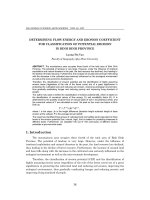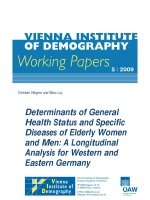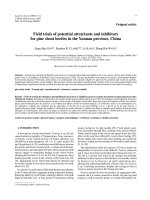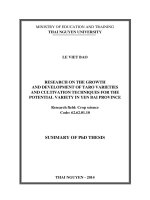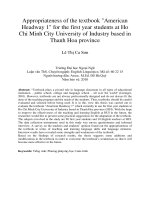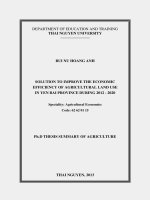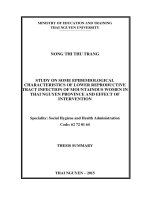Status and effective intervention of oral and dental diseases of mong pupils in primary schools in yen bai province
Bạn đang xem bản rút gọn của tài liệu. Xem và tải ngay bản đầy đủ của tài liệu tại đây (515.63 KB, 27 trang )
MINISTRY OF EDUCATION AND TRAINING
THAI NGUYEN UNIVERSITY
NGUYEN NGOC NGHIA
STATUS AND EFFECTIVE INTERVENTION
OF ORAL DISEASE IN MONG PRIMARY SCHOOL PUPILS
IN YEN BAI PROVINCE
SPECIALITY: SOCIOLOGY HYGIENE AND HEALTH ORGANIZATION
Code number: 62.72.01.64
SUMMARY OF MEDICINE DOCTORAL THESIS
THAI NGUYEN, 2014
The dissertation was completed at
UNIVERSITY OF MEDICINE AND PHARMACY
THAI NGUYEN UNIVERSITY
SUPERVISOR
Asso. Prof. Trinh Đinh Hai. PhD
Critic 1:
Critic 2:
Critic 3:
The dissertation will be defended nationally to the Evaluation
Committee at University of Medicine and Pharmacy, Thai Nguyen University
at …………… on ……………, 201
The dissertation is available for reference at:
- The library of Thai Nguyen University of Medicine and Pharmacy
- Learing resource centre of Thai Nguyen University
- The National Medical Library
1
BACKGROUND
Oral and dental disease are common diseases, having about 80 % of the
world population, all ages, all walks of life. According to the World Health
Organization (WHO) currently has approximately 5 billion people worldwide
suffer from periodontal disease, focused primarily in Asia and Latin America,
in the developed countries accounted for 60-90 % children of school age have
oral disease. Caries is a matter of the Governments of the countries concerned
launched several measures to solve. BRM is the cause of tooth loss, reduction
or loss of strength chewable adult as well as children. In Vietnam, according
to oral health survey in 2000, the national rate was 84,9 % milk tooth decay,
permanent tooth decay in children 6-8 years old was 25,4 %, this rate increase
by age and up to 69 % at ages 15-17. The rate of gingivitis was 45% and that
needs dental treatment are huge and urgent.
Yen Bai is a mountainous province faces many difficulties in health
care. The rate of dental disease primary pupils above 70 %. Over the years,
Yen Bai has no solutions, no specific pattern to reduce the incidence of dental
disease in a sustainable way down. The research question here is that
interventions to enhance oral health for Mong primary school pupils in Yen
Bai province. We studied the subject: "Status and effective intervention of oral
diseases in Mong primary school pupils in Yen Bai province" with the following
objectives:
1. Describe the current status of oral diseases in Mong primary school
puples in Yen Bai province 2011.
2. Analyze of some factors related to oral and dental disease of Mong
primary school pupils.
3. Evaluate the effectiveness of preventive intervention for oral and dental
disease in Mong primary pupils.
2
THE NEW SCIENTIFIC FINDINGS OF THESIS
1. The study identified that the rate of dental disease in Mong primary
school pupils in two mountainous districts in Yen Bai province is 71,4 % of
which tooth decay accounts for 69,6 % and gingivitis accounts for 50,1 %.
2. Model of community mobilization on taking care of dental health for
Mong primary school pupils are interested by community. In this model,
coordination among commune health centers, village health staff, school
teachers, schools and community leaders are very closed and effective.
Interventions has helped teachers and health workers make a better monitoring
and management of pupils’ health at the schools; it has also enhanced
awareness of parents and community in prevention of dental diseases at home.
Supervision activities have helped communal leaders and involved
stakeholders in evaluation of the intervention and adjust the intervention plan
timely in accordance with the real local situation. Intervention model has
affected parent’s behaviors and Mong people community. This is a basis for
them to give up habits which harm the pupils’ dental health.
3. Dissertation deeply studied Mong’s customs and habits of dental
health care for pupils. As the fact that, Mong people do not pay much
attention to their health. There are a lot of old customs and habits that harm
their health.
4. After intervention, knowledge, attitude and practice of pupils increased
respectively 36,9 %, 42,9 %, 68,3 %. Knowledge, attitude and practice of
teachers and pupil’s parents changed significantly, the teacher increased
respectively 74,9 %, 61,6 %, 76,8 %, the pupil’s parents increased respectively
47,5 %, 31,2 %, 35,1 %. Efficiency of intervention for tooth decay: milk tooth;
permanent tooth and gingivitis achieved respectively 7,2 %, 10,6 % and 34,4
%. Efficiency of intervention for periodontal disease (bleeding gums, tartar)
achieved 31,7 %.
3
STRUCTURE OF THE THESIS
The thesis 127 pages long, including the following sections:
- Background: 02 Page
- Chapter 1: Overview 35 Page
- Chapter 2: Subjects and Methodology 21 pages
- Chapter 3: Results of the study 39 pages
- Chapter 4: Discussion 28 pages
- Conclusion: 2 pages
The research results are presented in 47 tables, 04 charts, 04 figure, 02
diagrams, 09 qualitative result boxes, Thesis used 115 reference documents
including 56 references in Vietnamese and 59 in English.
SOME PART OF THE THESIS
Chapter 2
SUBJECTS AND METHODOLOGY
2.1. Study subjects
2.1.1 In quantitative research:
- The Mong pramary school pupils, they are learning from grades 1 to 5
- Parents of pupils, homeroom teacher
2.1.2. In qualitative research:
- Health staff of schools, school teachers
- Office of district Education and Training leaders
- The commune health workers, health staff of district health centre
- Head of the village, local government leaders
2.2. Location and time study
2.2.1. The location of study
At four pramary schools: Ban Cong school, Xa Ho school of Tram Tau
district and Nam Co school, Pung Luong school of Mu Cang Chai district,
Yen Bai province.
4
2.2.2. The time of study:
- Conducted in three years from 2011 to 2013.
2.3. Research Methodology:
- Cross-sectional descriptive study
- Intervention study
- Combining qualitative and quantitative study
2.3.1. Design of research
Intervention
Compare Compare
before and after
after
No
Intervention
Diagram 2.1. Chart comparing previous and after intervention
2.4. Sample of research
2.4.1. The sample size
2.4.1.1. The sample size in the description study
Applying the formula for sample size for discribed study:
p (1-p)
n = Z
1
2
- /2
d
2
In which:
n: is minimun sample size need to be researched.
p: Ratio of pupils with oral and dental disease, according to research
before (Dr Dao Thi Ngoc Lan researched 2002), p = 0,7, 1-p = 0,3
Nam Co, Ban Cong school
(the data before intervetion)
Collecting the data after
intervention
Xa Ho, Pung Luong school
(The data before intervention)
The data after
(Monitoring after
2 years)
5
d: desired accuracy is 0,05.
Z(1- /2) is coefficient of confident limit ( = 0,05, Z
2
(1- /2)) =1,96
0,7 x 0,3
n = (1,96)
2
= 330
(0,05)
2
Thus, each school study a minimum number is 330 pupils, 4 school is
1320 puples. In fact the survey, the number of pupils at four primary schools
is the 1370 pupils to study. We studied 1370 pupils.
2.4.1.2. The sample size of the intervention study
Apply the formula research community intervention follows:
2
12
2
221111
)(
)1()1()1(2
PP
PPPPZPPZ
n
In which:
P
1
= Proportion of pupils with oral and dental disease according to previous
study (The survey data previous intervention): 70 %
P2 = Proportion of pupils was expected at after intervention. It was estimated
50 %
P = (p
1
+ p
2
)/2 = 0,6 (60 %)
Z
1-
= is coefficient of confident limit (with = 0,05) = 1,96
Z
1-
= is coefficient of the sample capacity was expected ( =95 %) = 1,645
2
2
)5,07,0(
5,0.5,03,0.7,065,14,0.6,0.296,1
n
According to the calculation formula on n is 156 plus 10 % give up was
172 pupils. Thus, the number of pupils enrolled for minimum is 172 pupils in
each intervention group and the control group.
2.4.2. Techniques of choosing the sample
2.4.2.1. In discribed study
- Choosing the sample in quantitative study
+ Purposeful sampling: in two districts of Yen Bai province (Tram Tau
and Mu Cang Chai district). In this 2 districts have over 95 % Mong people,
who are living here.
6
+ Sampling schools:
We choose 4 primary schools by random draw method. So we had Ban
Cong primary school, Xa Ho primary school (in Tram Tau district), Pung
Luong primary school and Nam Co primary school (in Mu Cang Chai district).
+ Sampling pupils:
We choosed the entire sample; we made the list of pupil of 4 schools;
the pupils in each school choosed from class 1 to class 5. After that, we
surveyed under the this list and we had 1370 pupils. They are learning in 4
primary schools and all are Mong people.
+ Sampling teachers:
All the homeroom teachers who are teaching in four primary schools.
+ Sampling pupil’s parents:
We Choosed all parents of pupils in four primary schools, according to
the list of class. In fact, there were 1351 parents in four primary school, in
which, there were 19 parents had two children are learning at the same school
2.4.2.2. In the intervention study
We choosed each district 01 school by random draw methed to
implement intervention study. We had the Nam Co primary school in Mu
Cang Chai district and Ban Cong primary school in Tram Tau district. The
schools will perform intervention model (intervention group), actual
intervention group had 691 pupils, and the control group was Pung Luong
primary school in Mu Cang Chai district and Xa Ho primary school in Tram
Tau districts (control group), the actual control group had 679 students.
- Sampling in quantitative study
+ Group discussion: We conducted 4 group discussions in four school,
two group discussions in one school. In the first group discussion is included
health staff in commune level, village level, school teachers (8-12 people). In
the second group discussion is included commune leaders, head villages,
pupil’s parents (8-12 people)
+ In-depth interview: We conducted interview 01 leader of commune
people’s committee, head of commune health station, 05 homeroom teachers.
01 leader of district health centre, 01 leader of district Education and Training
department. 01 parents in each grade, 01 school health worker.
7
2.5. Content of study
2.5.1. For discribed study
- Oral examination to confirm the rate of dental caries, gingivitis and dental
manifestations of the disease (periodontal disease), index of dmf, DMF and CPI index
before intervention.
- Interview the primary school pupils, parents, homeroom teachers to identify
factors related to the pupils’ oral disease.
- Learning the environmental situation in the oral health care activities (teachers,
school health worker), in community (parents of pupil, communication)
2.5.2. For intervention study
2.5.2.1. Develop intervention model
After assessing the situation, determine the factors related to dental
disease, the researchers will gather communication materials on the basis of
the literature used to train the teachers, the core group of villages by the
Ministry of Health was regulated. Instructions building workshops and
training materials for the core group to organize and implement the activities
following the subjects
2.5.2.2. Implement the activities of intervention models
Implement the preventive intervention model of oral diseases for
primary school students:
- Prepare community activities included in the intervention schools.
- Develop a plan, work rules, the establishment of a steering intervention,
organizing the activities, monitoring and evaluation of interventions and
compared with the results of the initial investigation.
- Resources for implementation: Subject to mobilize resources is social health
officials, village and school teachers in addition to mobilize staff communes
and villages directly involved in research model.
- The Steering Committee consists of six people: Leadership CPC,
Representative school board school, board vice-Chairman of CHCs as deputy
director, officer in charge of medical schools, teaching team manager, head of
the village are members.
8
Training course, WS
oral disease examination
Comumication on knowledge
Diagram 2.2. Model mobilize community resources involved in
interventions for prevention of dental disease in Mong primary school pupil
2.6. The studied criteria
2.6.1. The studied criteria for objective 1
* The general information of research group:
- The characteristics of the pupils: age, gender, class…
* The criterria of the pupils with oral and dental disease
- The rate of pupils have oral and dental disease.
- The rate of pupils have gingivitis.
- The rate of decay-missing-filling on milk tooth and permanent tooth.
- The expression of periodontal gum disease (tartar, gingivitis and
bleeding gums).
- Results of depth interviews and workshop with related members of the
schools in two commune (qualitative research)
Intervention Leaders
of commune level
Core
group
Staffs health
station, village
health worker
Pramary
pupils
Parents of
pupils
Research
group
9
2.6.2. The studied criteria for objective 2
- The relationship between pupil’s knownledge, attitude practice in oral
health care and oral and dental disease.
- The relationship between parent’s knownledge, attitude practice in oral
health prevention and oral and dental disease.
- The relationship with the social conditions (health care, economic
component of household)
2.6.3. The studied criteria for objective 3
2.6.3.1. Group of indicators intervention models
- The index describes the results of implementing the intervention
model
+ Human resources: the number of participants models
+ On the material: The material has been prepared for training,
communications, facilities used in the research process.
+ About the organization model: Decision establishment of direct
intervention model, assigning tasks to members of the Steering Committee,
operating rules.
- The index of the performance of the model
- The monitoring indicators of intervention activities
2.6.3.2. The group of indicators describing the performance of health
communication and education about oral health care
In quantitative research: effective interventions for knowledge, attitude
and practice of pupils, parents, school teachers of the two groups before and
after intervention.
- In qualitative research: evaluating subjects (pupils, parents, teachers)
on the results of health education and communication.
2.6.3.3. Group counseling indicators of treatment consultancy
- The pupils were consulted treatment.
- Number of pupils were moved to higher level
- The pupils were consulted to prevent the complications.
2.6.3.4. Results capacity for core group in the implementation of activities in
the village, at the school.
- The training courses were implemented
- The number people participant training courses and workshop
10
- The results of training courses
2.6.3.5. Results of coordinated methods for the prevention of pupils oral
diseases.
- Effective application of the intervention methods in quantitative research.
- Maintain and expand the model intervention.
2.7. The assessment of knowledge, attitude and practice of oral health
care of pupils
In this study, based on interviews with questionnaires and checklists to
assess the knowledge, attitude and practice of students, teachers and parents.
Each correct answer is counted as 1 point, wrong answer no points. The total
point of knowledge, attitude and practice is divided into 3 main level: weak,
average, good, under the classification of Bloom as follows:
- The number of point is 8-10 (≥ 80 %): Good.
- The number of point from 6-7 (60-79 %): Average
- The number of point under 6 (≤ 60 %): Weak
2.8. Standard classification of poor and non-poor household:
According to Decision No. 09/2011 / QD-TTg dated 30/01/2011 of the Prime
Minister on the issuance poverty line, poor households applied for 2011-2015
states: poor households in rural / mountains are households with an average
income of 400,000 VND / person / month (from 4.8 million VND / person /
year) or less. Thus, poor households are households with an average income of
401,000 VND / person / month or more.
The other evaluation criteria:
- Check your oral health routine: Organizations oral examinations for
pupils at schools in 6 months a time. In order to detect oral diseases and
counseling, guiding, families of pupils take examinations and treatment.
- Guide oral hygiene routine: The pupils are instructors oral hygiene
(brushing, gargling, prevention of disease risk factors Dental) weekly
classroom teacher dean or school health personnel perform.
- Eat regularly shoots peppers: the students ate pickled chilli bamboo
shoots in the daily meal. Not regular eat as monthly, weekly and eat once or
not eat.
2.9. Review effectiveness of the intervention
- Test
2
was used to compare 2 proportion (%)
- The difference with statistical significance was assessed at p <0,05
11
- Evaluation of intervention based on effective indicators and effective
intervention.
- The effective indicator as formula:
p1 – p2
Effective indicator (%) = x 100
p1
Trong đó: p1 is proportion of study before intervention
P2 is proportion of study after intervention
- Effective intervention as formula (%)
Effe indicator (Intervention grour) – Effe. indicator (control grour)
2:10. Evaluating of community acceptance for intervention
- Based on qualitative research, information was recorded, classified by
contents and assessmented the results.
Chapter 3
RESULTS OF STUDY
3.1. Status of oral diseases in Mong primary school pupils
Table 3.4. The rate of oral disease follow school (n=1370)
Disease
Schools
Oral disease
Have disease
No disease
Number
%
Number
%
Ban Cong
226
65,3
120
34,7
Nam Co
254
73,6
91
26,4
Xa Ho
220
67,5
106
32,5
Pung Luong
278
78,8
75
21,3
Total
978
71,4
392
28,6
Comment: Incidence oral disease of the pupils are 71,4 %. In Ban Cong
school is 65,3%, Nam Co school is 73,6 %, Xa Ho school is 67,5 %, Pung Luong
78,7 %. The number of pupils do not have oral disease is 28,6 %, incidence
between the schools are similar.
12
Table 3.7. The rate of milk tooth decay follow school
Disease
Schools
n
Cavities
No cavities
Number
%
Number
%
Ban Cong
346
218
63,0
128
37,0
Nam Co
345
227
65,8
118
34,2
Xa Ho
326
198
60,7
128
39,3
Pung Luong
353
219
62,0
134
38,0
Total
1370
862
62,9
508
37,1
Comment: The rate of pupils of milk tooth decay are 62,9 %, Ban Cong
school is 63,0 %, Nam Co school is 65,8 %, Xa Ho school is 60,7%, Pung Luong
school is 62,0 %. The rate of infant milk tooth decay of pupils are similar.
Table 3.8. The rate of permanent tooth decay follow school
Disease
Schools
n
Cavities
No cavities
Number
%
Number
%
Ban Cong
346
156
45,1
190
54,9
Nam Co
345
131
38
214
62,0
Xa Ho
326
123
37,7
203
62,3
Pung Luong
353
160
45,3
193
54,7
Tổng
1370
570
41,6
800
58,4
Comment: The rate of permanent tooth decay is 41,6 %, Ban Cong school is
45,1 %, Nam Co school is 38 %, Xa Ho is 37,7 %, Pung Luong is 45, 3 %.
13
Table 3.9. Indicator of decay, lost, fill and structure decay, missing,
filling on milk tooth and permanent tooth
Features
Num.
Milk tooth
Permanent tooth
Tooth
decay
Tooth
missing
Tooth
filling
dmf
Tooth
decay
Tooth
missing
Tooth
filling
DMF
Quantity
1370
4541
985
53
5579
1630
457
50
2137
Indicator
3,3
0,7
0,03
4,1
1,2
0,3
0,03
1,6
Comment: The indicator decay-missing-filling (dmf) on milk teeth was
4,1, index cavities was 3,3, tooth missing was 0,7. The indicator decay-
missing-filling on permanent tooth (DMF) was 1,6.
3.2. The factors related to oral disease in primary school pupils
3.2.1. The factors related to oral disease in quantitative study
The research team conducted a study and analysis of some factors related to
oral and dental disease of primary school pupils who have eating habits is not
good, the oral health care regularly, knowledge, practice oral hygiene of pupils, the
results are as follows:
Table 3.17. The relationship between knowledge and oral disease in the
primary school pupils
Disease
Knowledge
Oral disease
OR, p
2
Have
No have
Number
%
Number
%
Not good
635
80,4
155
19,6
p<0,001
2
=72,8
OR=2,8
Good
343
59,1
237
40,9
Total
978
71,4
392
28,6
Comment: There is an association between oral disease and oral care
knowledge of the pupils, the pupils have poor knowledge will have oral
disease incidence higher than pupils who have a good knowledge.
14
Bảng 3.19. The relationship between tooth brushing everyday in pupils
and oral disease
Disease
Practical
Oral disease
OR, p
2
Have
No have
Number
%
Number
%
Not good
589
74,8
198
25,2
p<0,05
2
= 10,4
OR=1,4
Good
389
66,7
194
33,3
Total
978
71,4
392
28,6
Comment: There is an association between dental practice daily brush with
dental disease, the pupils practice poor oral hygiene, the incidence of oral
higher than the pupils to practice brushing good daily.
Bảng 3.20. The relationship between oral health care regularly
and oral disease (n=1370)
Disease
Oral health care
Oral disease
OR, p
2
Have
No have
Number
%
Number
%
Not regular
759
79,6
194
20,4
p<0,001
2
=7,6
OR=3,5
Regular
219
52,5
198
47,5
Total
978
71,4
392
28,6
Comment: There is an association between oral disease to diagnose and
treat oral diseases regularly, the pupils do not get regular medical examination,
the prevalence of oral disease was higher than students who were examined
regularly.
3.3. Effective prevention interventions in Mong primary school pupils
3.3.1. Results implement intervention model:
3.3.1.1. The results of training the core group
The team building activities planned for the process and monitor,
supervise and evaluate the results achieved:
The research team has organized two workshops, each social class.
Participants in the training is done Steering Committee model, the core group
15
consists of (school teachers, commune health workers, villages chief). The
results are as follows:
Table 3:26. Evaluation results for staff training of core group
Location
evaluation
Nam Co commune
Ban Cong commune
Before training
After training
Before training
After training
Num.
%
Num.
%
Num.
%
Num.
%
Good
4
16,0
9
36,0
3
13,6
7
31,8
Rather
5
20,0
11
44,0
7
31,8
12
54,6
Medium
11
44,0
5
20,0
9
40,9
3
13,6
Weak
5
20,0
0
0,0
3
13,6
0
0,0
Total
25
100,0
25
100,0
22
100,0
22
100,0
Comments: Before the training, the students understanding of periodontal
disease is low, with good level (Nam Co 16 %, Ban Cong 13,6 %), after
training rate has increased quite with good level (Nam Co 36 %, Ban Cong
31,8 %) and did not have any person classified as weak.
3.3.1.2. The results of specific activities of the participants in the intervention
model.
Before the operation of the team members have advised the CPC
decision established the Steering Committee for implementation of
interventions by the Deputy Chairman of the commune chief, general
administration, the member of the Board representing school administrators,
teacher union team, representing the commune health workers, representatives
of village heads and representatives of village health workers, total is 6
people. The mission of the member is assigned and mainly focuses on the
direction, management, monitoring and evaluation activities to be
implemented in the commune
3.3.2. The effectiveness of interventions in health communication and
education in the prevention of oral disease for pupil in quantitative
research.
16
Table 3.28. Knowledge in preventive oral disease of pupils before
and after intervention
Time
Knowledge
Interven. group
(n=691)
Control group
(n=679)
p
(
2
test)
Num.
%
Num.
%
Before
intervention
Good
225
32,6
224
33,0
p>0,05
Medium
274
39,7
298
43,9
Weak
192
27,8
157
23,1
After
intervention
Good
314
45,4
230
33,9
p<0,001
Medium
290
42,0
299
44,0
Weak
87
12,6
150
22,1
p (
2
test)
p<0,001
p>0,05
Effect. index % (good)
39,6
2,7
Intervention effect. (%)
36,9
Comment: There has been a change in the student's knowledge level of
"good" at times before and after the intervention, effective interventions to
knowledge was increased 36,9 %.
Table 3.29. Attitude of pupil’s prevention before and after intervention
Time
Attitude
Interven. group
(n=691)
Control group
(n=679)
p
(
2
test)
Num.
%
Num.
%
Before
intervention
Good
261
37,8
257
37,9
p>0,05
Medium
286
41,4
293
43,2
Weak
144
20,8
129
19,0
After
intervention
Good
379
54,9
263
38,7
p<0,05
Medium
254
36,8
298
43,9
Weak
58
8,4
118
17,4
p (
2
test)
p<0,01
p>0,05
Effect. index % (good)
45,2
2,3
Intervention effect. (%)
42,9
17
Comments: There has been a change in the pupils’ attitudes at the
"good" in the period before and after the intervention, the effective
intervention on attitudes increased 42,9 %.
Table 3.30. Practice of pupil’s prevention before and after intervention
Time
Practice
Interven. group
(n=691)
Control group
(n=679)
p
(
2
test)
SL
%
SL
%
Before
intervention
Good
188
27,2
190
28,0
p>0,05
Medium
259
37,5
262
38,6
Weak
244
35,3
227
33,4
After
intervention
Good
347
50,2
221
32,6
p<0,001
Medium
210
30,4
269
39,6
Weak
134
19,4
189
27,8
p (
2
test)
p<0,001
p>0,05
Effect. index % (good)
84,6
16,3
Intervention effect. (%)
68,3
Comment: Through the intervention had a change in the practice of pupils in
the "good" at the time before and after the intervention, effective intervention
to increase 68,3 % attitude.
Table 3.32. Effective intervention of teacher’s KAP
KAP
Effective index (%)
Effective
intervention
(%)
Interven. group
Control group
Knowledge
103,5
28,6
74,9
Attitude
63,4
1,9
61,6
Practice
96,8
20,0
76,8
p (
2
test)
p<0,001
Comment: The effective intervention for oral disease prevention’s KAP of
teachers had changed, knowledge 74,9 %, attitude 61,6 %, practice 76,8 %.
18
Table 3.34. Effective intervention of parent’s KAP
KAP
Effective index (%)
Effective
intervention
(%)
Interven. group
Control group
Knowledge
48,9
1,4
47,5
Attitude
31,2
0,0
31,2
Practice
36,8
1,7
35,1
p (
2
test)
p<0,001
Comment: The effectiveness of interventions for oral disease prevention
knowledge of parents was 47,5 %, attitudes 31,2 %, practice 35,1 %.
3.3.3. The effectiveness of interventions in health communication and
education for pupils in qualitative research.
Through group discussions and in-depth interviews of 16 officers are
school teachers, commune health workers, commune, village’s leader of the
two intervention commune, results were as follows:
- Communication and education was to raise awareness for pupils, teachers,
parents contribute to enhancing the prevention of oral diseases is essential
- Intervention model with communication coordination among sectors
participated (health and education), the government and the people that fit.
- Communication model oral disease prevention has more impact on the
perception of local leader health care to children.
3.3.4. Effective coordination of interventions for oral disease in primary
pupils in quantitative research.
3.3.4.1. For tooth decay
Table 3.36. The effective index and intervention effectiveness for milk
tooth and permanent tooth
Group
Milk tooth
Permanent tooth
Interven.
Control
Interven.
Control
Before intervention
64,4
61,41
41,5
41,7
After intervention
64,7
66,1
42,1
46,7
Effect. index %
0,5 %
7,7 %
1,4 %
12,0 %
Intervention effect. (%)
7,2
10,6
p (
2
test)
p<0,05
p<0,05
19
Comment: Through the implementation of preventive intervention model for
periodontal disease of Mong primary school pupils showed the effectiveness
of the intervention group higher than the control group in both types of teeth.
Remarkably effective intervention for milk teeth is 7,2 %, for the permanent
tooth is 10,6 %.
Table 3.39. The effective index and intervention effectiveness for index of
decay-missing- filling on milk tooth and permanent tooth
Tooth
Group
Milk tooth
Permanent tooth
Interven.
Control
Interven.
Control
Before intervention
4,1
4,0
1,6
1,5
After intervention
4,1
4,2
1,6
1,6
Effect. index %
0,5
3,7
1,9
7,2
Intervention effect. (%)
3,2
5,3
p (
2
test)
p<0,001
Comments: After the implementation of intervention activities for the
intervention group, the efficiency index was higher than the control group for
both types of teeth. The effective intervention was changed between the two
groups and have different.
3.3.4.2. For Periodontal disease:
Table 3.43. Effective index intervention effectiveness
for periodontal disease
Nhóm
Periodontal disease (CPI 1 + CPI 2)
Intervention group (3)
Control group (4)
Before intervention (1)
63,5
66,9
After intervention (2)
51,5
75,3
Effect. index %
18,9
12,6
Intervention effect. (%)
31,5
p (
2
test)
p(2,3)<0,001
Comments: After the intervention, efficiency Index of intervention
schools was higher than the control group, the effectiveness of interventions
20
for intervention schools with bleeding gums and tartar increased 31.5%, with
the obvious changes and have different between the two groups.
3.3.4.3. For gingivitis
Table 3.47. Effective index intervention effectiveness for gingivitis
Group
Gingivitis
Intervention group(3)
Control group(4)
Before intervention (1)
48,2
52,1
After intervention (2)
37,1
58,0
Effect. index %
23,1
11,3
Intervention effect. (%)
34,4
p (
2
test)
p(2,3)<0,05
Comment: The preventive interventions was changed for gingivitis. The
effective intervention for gingivitis was 34,4 %, with the difference between
the two groups.
3.3.5. Effective coordination of interventions methods for Mong primary
school pupils in qualitative research.
After 2 years, implementing the intervention model to enhance the
prevention of oral diseases for primary school children in two communes, the
team received feedback from members of the Steering Committee, school
teachers, medical staffs and pupils’parents about the effectiveness of this
intervention:
Box 3.6. The ideas on organization of intervention model
“…The organization of the model is very compact, easy to carry outsize and
inexpensive funding to operate. Time, place and content-appropriate activities
with members of the Steering Committee and are able to deploy their work
favorably. Supervision and inspection is done regularly contributes to remind
organizations, units, people solve their problems, difficulties and more
interested in this work…”
Ban Cong commune people’s committee
21
Box 3.7. The idea of performing professional activities
“ Operation of model mainly communication, counseling, regular oral
examinations, oral hygiene instructions this is one of the content easy to
perform at community health workers that ever not been fully implemented.
This model provides teachers, parents and students with the knowledge,
attitudes and practices of care for children's dental health. From now on
commune health station will care more, more often, to coordinate
implementation with other health programs for the health of the Mong pupils
improved better now…”
Nam Co commune health station
3.3.6. The some results of the method management capacity for core
team in oral and dental health care.
The school teachers, health workers and other members in the core
group has been providing information, content related to the prevention of oral
diseases for pupils. Especially organizational capacity operation, management,
supervision and monitoring of officers involved have been strengthened,
contribute to the implementation of the intervention activities.
In the process of implementing the intervention, officials core group has
been involved in many workshops and seminars on oral health care, to
exchange and learning experience in other elementary schools in the district
and beyond. So, The people, who direct communication and organizational
communication activities have been summarized the experience and improve
themselves by themselves. Results interviewed 16 staff on the steering
committee of the two communes and the core group shows:
- Officer of the Board of school administrators understand the method,
implementation, communication skills, counseling for students in health care
and prevention of oral diseases.
- Officer of the Steering Committee as well interventions inspection,
supervision and evaluation of communication activities in the community.
- Homeroom teacher to understand the content of all media and oral
hygiene instruction for students in the class.
- The medical staff understand the process and organizational oral
health screenings at schools and at health centers.
22
Village chiefs and village health has been directly implementing
communication activities in the village, held talks in villages and
communication skills of village health workers was raised.
Beside the professional activities, the teachers have good management,
especially pupils have health management books and regular monitoring at
school. Timely detection the complications to soon treatment, the homeroom
teacher informed promptly and regularly to the family about the health of the
pupils.
CONCLUSIONS
1. Status of oral disease in Mong primary school pupils
Percentage of Mong primary school pupils have oral disease accounts for 71,4
%. Tooth decay 69,6 %, gingivitis 50,1 %; the rate of tooth decay and gingivitis in
pupils of the school was similar.
- The rate of tooth decay and gingivitis increases with age, 7-year-old pupils
was 67,5 %, 11-year-old pupils was 74,7%. Gingivitis in 7-year-old pupils was 48,0
%, at 11 years old was 54,3 %
- Percentage of pupils in milk tooth decay average 62,9 %, permanent tooth
decay 41,6 % .
- The average indicator of milk tooth decay is 3,3, decay-missing- filling of
milk tooth is 4,1. Average indicator of permanent tooth is 1,18, decay-missing- filling
of permanent tooth is 1,6.
- Percentage of students with bleeding gums is 13,1 %, the percentage of pupils
with tartar (plaque) was 52,1 %.
2. The some factors related to oral and dental disease
- There was relationship between oral disease and knowledge of Mong
primary school pupils .
- There was relationship between the practice of daily brushing; the
examination and routine dental treatment; the oral hygiene instruction in the
classroom with oral disease.
- Have no relationship between economic household and oral disease,
pupils from poor and rich households are risk.
23
3. The effectiveness of some preventive interventions dental disease
3.1. Effectiveness of the intervention model
Model mobilize community participation in health education and
prevention of oral diseases for Mong primary school pupils in Yen Bai
province has implemented efficiently by implementing the activities and focus
on improving the knowledge, attitude and practice of dental hygiene students,
teachers and parents.
The model has a ripple effect to local governments, departments of
social and people interested in particular the Steering Committee and core
group model has been implemented to strengthen the management capacity,
which practice, specializing in health care.
3.2. Effective change communication KAP of preventive oral health for
pupils, teachers and parents
After the intervention of the intervention group, the percentage of good
knowledge of students increased by 36,9 %, 42,9 % increase good attitude and
good practice increased 68,3 %.
KAP of teachers also changed considerably, the effectiveness of
interventions for prevention BRM knowledge of teachers increased by 74,9 %,
61,6% increase attitudes, practices increased 76,8%.
The effectiveness of preventive interventions for parents increased
kn47,5 %, 31,2 % increase attitudes, practices 35,1 %.
3.3. Effectiveness of tooth decay and gingivitis.
3.3.1. For tooth decay
- Effective intervention group higher than the control group in both
types of teeth. Remarkably effective intervention for baby teeth is 7,2 %, for
the permanent teeth is 10,6 %.
- The effectiveness of interventions for deep index lost fillings milk in
the intervention group reached 3,2 %, with permanent teeth in the intervention
group 5,3 %
3.3.2. For periodontal disease
Percentage of bleeding gums and tartar after the intervention
significantly reduced
The effectiveness of interventions for bleeding and tartar were 31,7 %,
with the changes and differences between the two groups before and after the
intervention
- Effectiveness of the gingivitis was 34,4 %
